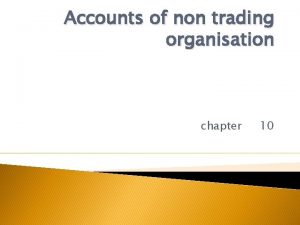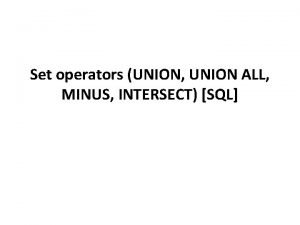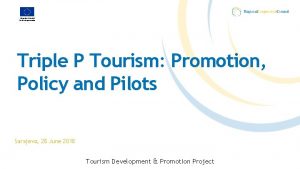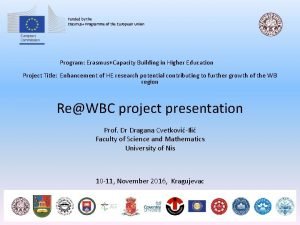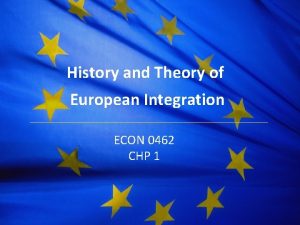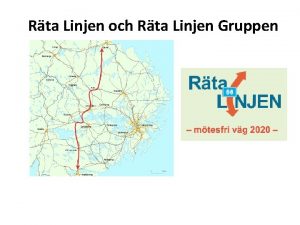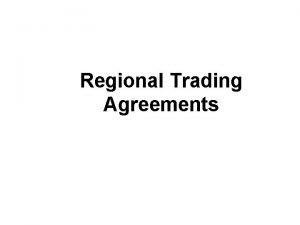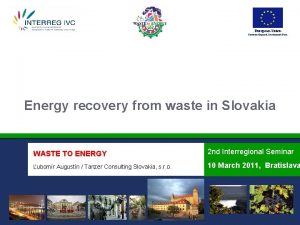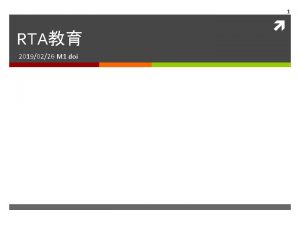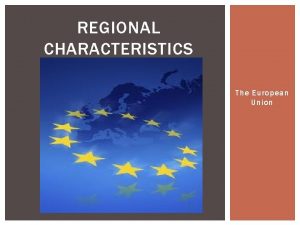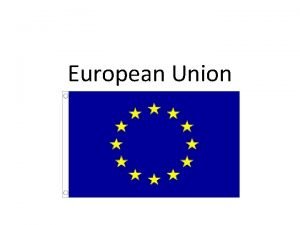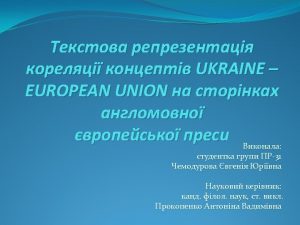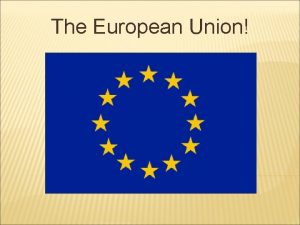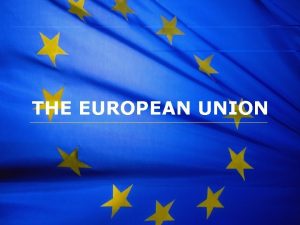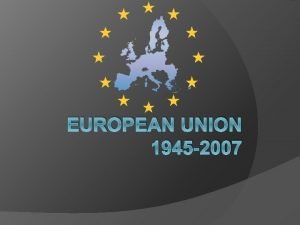Regional Trading Agreements European Union 1 RTA 1945











- Slides: 11

Regional Trading Agreements European Union 1

RTA 1945 – 1959 A peaceful Europe – the beginnings of cooperation • Aim of ending the frequent and bloody wars between neighbors. • As of 1950, the European Coal and Steel Community begins to unite European countries economically and politically in order to secure lasting peace. • The six founders are Belgium, France, Germany, Italy, Luxembourg and the Netherlands. 2

RTA 1960 – 1969 The ‘Swinging Sixties’ – a period of economic growth • EU countries stop charging custom duties when they trade with each other. • They also agree joint control over food production, so that everybody now has enough to eat – and soon there is even surplus agricultural produce. 3

RTA 1970 – 1979 A growing Community – the first Enlargement • Denmark, Ireland the United Kingdom join the European Union on 1 January 1973, raising the number of member states to nine. • The EU regional policy starts to transfer huge sums to create jobs and infrastructure in poorer areas. • The European Parliament increases its influence in EU affairs and in 1979 all citizens can, for the first time, elect their members directly. 4

RTA 1980 – 1989 The changing face of Europe - the fall of the Berlin Wall • In 1981, Greece becomes the 10 th member of the EU and Spain and Portugal follow five years later. • In 1987 the Single European Act is signed. This is a treaty which provides the basis for a vast sixyear programme aimed at sorting out the problems with the free-flow of trade across EU borders and thus creates the ‘Single Market’. 5

RTA 1990 – 1999 A Europe without frontiers • In 1993 the Single Market is completed with the 'four freedoms' of: movement of goods, services, people and money. • The 1990 s is also the decade of two treaties, the ‘Maastricht’ Treaty on European Union in 1993 and the Treaty of Amsterdam in 1999. • In 1995 the EU gains three more new members, Austria, Finland Sweden. 6

RTA 2000 – today A decade of further expansion • The euro is the new currency for many Europeans. • 11 September 2001 becomes synonymous with the 'War on Terror' after hijacked airliners are flown into buildings in New York and Washington. • 10 new countries join the EU in 2004. (The Czech Republic, the Republic of Estonia, the Republic of Cyprus, the Republic of Latvia, the Republic of Lithuania, the Republic of Hungary, the Republic of Malta, the Republic of Poland, the Republic of Slovenia and the Slovak Republic –– pending on ratification by each of the accession countries) (25 members) • Many people think that it is time for Europe to have a constitution but what sort of constitution is by no means easy to agree, so the debate on the future of Europe rages on. 7

RTA The objectives of the European Union Objectives are listed in the Preamble, Common Provisions, and Final Provisions of the Treaty. – End the division of the European continent – Confirm the attachment to the principles of liberty, democracy and respect for human rights and fundamental freedoms and the rule of law – Deepen the solidarity between the peoples while respecting their history, their culture and their traditions. – (Build) an ever-closer union in which the decisions are taken as openly as possible and as closely as possible to the citizen. – ) an ever-closer union in which the decisions are taken as openly as possible and as closely as possible to the citizen. 8

RTA – (Build) an ever-closer union in which the decisions are taken as openly as possible and as closely as possible to the citizen. – Respect the national identities of its Member States. – Accept application of membership of the union from any European state, which respects the principles set out in Art. 6(1) (human rights, fundamental freedoms, respect of minorities, etc. 9

RTA -Promote economic and social progress for their peoples, taking into account the principle of sustainable development and within the context of the internal market and of reinforced cohesion and environmental protection. 10

RTA The objectives of the EU are not primarily economic. This makes EU to be more than a forum for economic cooperation and the Treaty something similar to a constitution, though, with an emphasis on economic issues. 11
 Life membership fees of non trading concern is
Life membership fees of non trading concern is Sql union minus intersect
Sql union minus intersect Co-funded by the erasmus+ programme of the european union
Co-funded by the erasmus+ programme of the european union This project is co-funded by the european union
This project is co-funded by the european union European union military
European union military Eureka european commission
Eureka european commission This project is funded by the european union
This project is funded by the european union Co-funded by the erasmus+ programme of the european union
Co-funded by the erasmus+ programme of the european union Co-funded by the erasmus+ programme of the european union
Co-funded by the erasmus+ programme of the european union Borchert model ap human geography
Borchert model ap human geography European union history
European union history This project is funded by the european union
This project is funded by the european union
